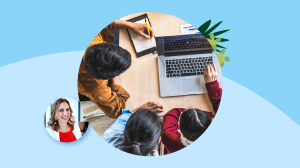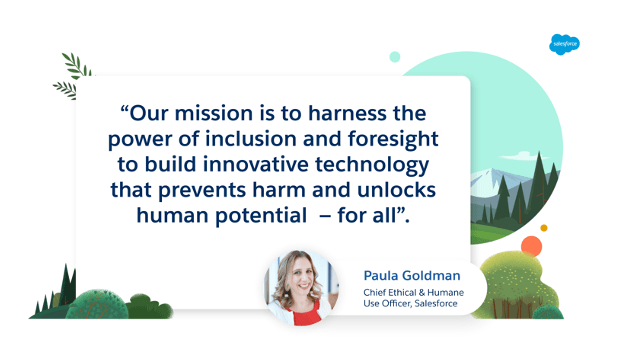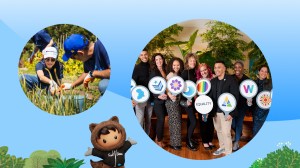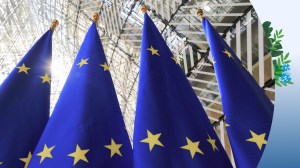Building ethically and inclusively takes more than good intentions. It takes a solid plan, and the ambition to build a movement bigger than any one company. That’s why at Salesforce, we’re leading by example with a focus on intentional innovation.
By putting passion, planning, and powerful tools into every step of our design and management process, we show that ethics, inclusion, and accessibility deliver real-world value. For us, progress isn’t just something to patent. Here are some of the ways we’re working to build a brighter future:
Scanning for unintended consequences and mitigating risk
We leverage diverse perspectives to think through complex issues and creatively problem-solve to mitigate ethical risks in our products. We use Build with Intention workshops, an expansion of an idea created by UK-based think tank Doteveryone, to consider the unintended consequence of our technology and create action plans to add ethical guardrails in our software and services.
Through Build with Intention workshops, we are able to intentionally take time to reflect on the positive and negative consequences of our work, and build features that better enable the safety and success of our customers and their customers.
This process can be helpful for anyone in the tech space. That’s why we’ve built a step-by-step guide to innovating thoughtfully, based on our experiences. You can find our toolkit with tips, resources, and practical insights here.
Embedding ethical features into products — by design
We strive to intentionally embed ethics into our products and services by design, empowering our engineering and product teams from the very outset to consider the impact of the technology they create.
Through our Ethics by Design work, we are helping teams innovate ethical pandemic-response technology, inform our teams’ creation of trusted Artificial Intelligence (AI) products, guide Salesforce’s efforts in ethical marketing personalization, and emphasize a human-centric approach to Customer Service — all of which empower our customers and users to use data and AI responsibly.
Empowering teams with a robust process to build accessibility and inclusion into our culture
We aspire to use inclusive design to break the cycle of exclusion, helping to create products, services, and experiences that users of all capabilities can access.
To ensure our products are accessible to all, our Accessibility Support Engineers are experts in accessible technology, including WCAG standards and Section 508, and certified Salesforce Administrators.
And, to help others build more accessible products, we’ve launched Sa11y, our accessibility test automation framework. Sa11y is open-sourced, so all developers can take advantage of its features to promote accessibility in the tools they’re creating.
Leveraging research and conversations across difference to implement guardrails
In addition to building ethics and inclusion into our products, we seek to understand the direct impacts of our technologies in the world — and prevent the misuse of our technology.
While we can’t always predict what will happen, or what unintended consequences will arise, we do have a robust and repeatable process to address concerns, which centers on active listening and engaging in difficult conversations. We’ve opened up various channels for listening to concerns, including an email alias, a Salesforce “Ethicspoint” site, an internal Slack Channel, and open office hours for employees.
Engaging diverse perspectives through our Ethical Use Advisory Council
We also leverage an Ethical Use Advisory Council — made up of a diverse group of external experts, internal executives, and frontline employees — to receive critical feedback on our policy decisions from various points of view.
The Council meets regularly to have constructive conversations across the spectrum of human ability, experience, and perspective. Its guidance ensures that we address the impacts of modern technology collaboratively, consider a wide set of perspectives, and mitigate risk.
While getting input on our work from a variety of individuals can slow down the decision-making process, it ultimately results in better policies and features that our customers and their end users benefit from, such as prohibiting the use of our AI products for facial recognition.
Building relationships through workshopping and toolkits
Going beyond our own business is essential to making tech work for everyone. In addition to providing resources, we hope to continually refine and expand our approach through feedback, and we’re proud to already have input from participants.
Salesforce Experience Architect Chip Russel highlights the importance of the experience. “To be human-centered and design-led,” he said, “we must be empathetic and purposeful in considering the human consequences of our decisions we make with our customers everyday.”
Joanne Tateishi, Senior Experience Designer, shares a similar perspective: “Consequence scanning is important to pause and collectively understand innovative ideas thoroughly that may disrupt or change people’s actions. The scale of our impact matters in the tech industry and we see it all around us every day. It should be mandatory for us to get this right and have these conversations early with the right people so that there is no confusion about what may or may not happen as a result. It’s just good consulting, not to abdicate our role in this decision making.”
Perspectives like these reinforce the value of leveraging tools like our workshops to expand horizons and bring more people into the process of building better tech. Check out the toolkit today. We welcome your perspective through our dedicated feedback email.
Join us on our journey
We can’t do this alone, and we’re learning with each step we take. Ethical and inclusive technology relies on all of us — investors, executives, engineers, and everyone who supports them. It’s all of our legacies as an industry and as a society.
Technology has the power to change the world. And we have the power to change technology, for the better.
Salesforce’s Ethical and Humane Use website offers information and materials to help anyone build a better future for all. Find it here.




















